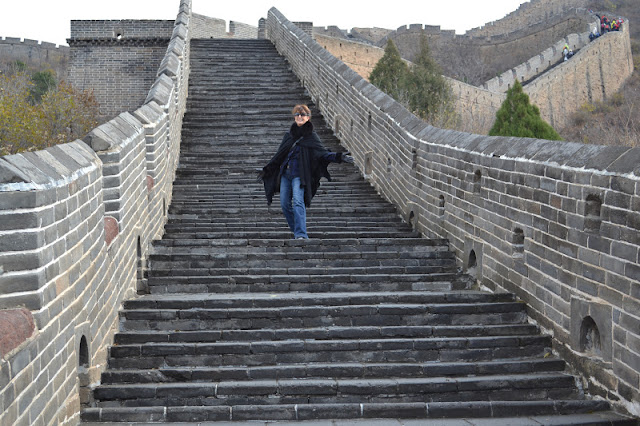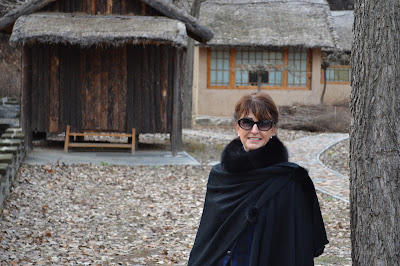Living in Seoul means as well that we’ve the possibility to visit”nearby” countries. Our second visit outside the Republic of Korea went to Beijing, which is only a two hour flight from Seoul.
Beijing, (Chinese for:”the Northern Capitol”) is the capitol of the Republic of China since October 1949. (Which it has been during different periods) The total population of the administrative area of the city is 19.6 million (2010), in central Beijing 7.6 million people (2007) are registered.
This city is Chinas political and cultural centre, while Shanghai still is mentioned to be the countries economical center.
Few cities have had so many different names as Peking.
First time this city was mentioned was the year
1121 BC and was named Ji. Afterwards the city was named Yan, a name still used
by Chinese poets. Between 618 and 1424 the city had many different names (about
eight), but during Yongle’s rule, 1403-1424 (a later emperor of the Ming
dynasty) his residence was move to Peking,
and the city became the capitol.
The name
change from Peking to Beijing depends on the pronunciation, for the first one
was influenced by the French Catholic missionaries in the 17th century.
Today most of the world countries pronounce the name as Beijing.
We arrived shortly after the worst snow weather the area had seen since 61 years. Well installed at our hotel we discovered that internet access was limited and I had no access to Facebook or my blog site, the 38th Parallel. We learned from our guide that the last two mentioned were stopped in 2010. However, Instagram was accessible, what some of you noticed.
This immense city, being very modern and spiced with lots of culture, going back thousands of years, gives its inhabitants and visitors plenty to see, do and learn. Although, nor the Koreans or the Japanese like to hear it, we recognized many similarities.
Please join me for some of the fabulous sites we’ve seen, the things we have done and the thoughts we had.
 |
| We started up with purchasing umbrella's.... |
 |
| One street behind the major road to "Pearl Heaven" |
 |
| Friendly, smiling and no..... negotiating!!! |
 |
Hudge, exiting and.....exhausting!  |
 |
| 30 metres in diameter! |
The Temple of
Heaven (build 1420), literally the Altar of Heaven, (in simplified Chinese: 天坛), is a complex of religious buildings
situated in the southeastern part of central Beijing, (not far from “Pearl
Heaven”). The complex was visited by the Emperors of the Ming and Qing
dynasties for annual ceremonies of prayer to Heaven for good harvest. It has
been regarded as a Taoist temple, although Chinese Heaven worship, especially
by the reigning monarch of the day, pre-dates Taois.
 |
| The trees in the 675 acres park, are as old as 500 years!!! |
The following day, time time had come to visit one of the sites of the Great Wall, one of my wishes to see in the world!
 |
| What road to take.....Hmm how many are there? |
 |
| But first a visit to " JINSHANLING coffee shop". |
A short walk before climbing upwards and walking for an 1.5 hours on
"The Great Wall"!

 |
| Let history be felt. |
 |
| .....Some history! |
 |
| Many, many man hours for the building of the Great Wall! |
 |
| What a view, what a historical place! |
 |
| Mongolia.... |
The Great Wall of China is a series of fortifications made of stone, brick, tamped earth, wood, and other materials, generally built along an east-to-west line across the historical northern borders of China in part to protect the Chinese Empire or its prototypical states against intrusions by various nomadic groups or military incursions by various warlike peoples or forces. Several walls were being built as early as the 7th century BC these, later joined together and made bigger, stronger, and unified are now collectively referred to as the Great Wall. Especially famous is the wall built between 220–206 BC by the first Emperor of China, Qin Shi Huang. Little of that wall remains. Since then, the Great Wall has on and off been rebuilt, maintained, and enhanced; the majority of the existing wall was reconstructed during the Ming Dynasty.
Other purposes of the Great Wall have included border controls, allowing the imposition of duties on goods transported along the Silk Road, regulation or encouragement of trade and the control of immigration and emigration. Furthermore, the defensive characteristics of the Great Wall were enhanced by the construction of watch towers, troop barracks, garrison stations, signaling capabilities through the means of smoke or fire, and the fact that the path of the Great Wall also served as a transportation corridor.
The Great Wall stretches from Shanhaiguan in the east, to Lop Lake in the west, along an arc that roughly delineates the southern edge of Inner Mongolia. A comprehensive archaeological survey, using advanced technologies, has concluded that the Ming walls measure 8,850 km (5,500 miles). This is made up of 6,259 km (3,889 miles) sections of actual wall, 359 km (223 mi) of trenches and 2,232 km (1,387 miles) of natural defensive barriers such as hills and rivers. Another archaeological survey found that the entire wall with all of its branches measure out to be 21,196 km (13,171 miles).
 |
| Proof .... we did walk on the historical "Great Chinese Wall".
To be continued........................
|

















No comments:
Post a Comment